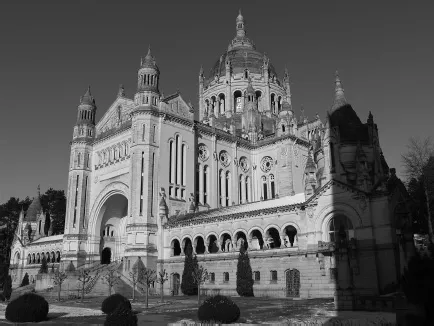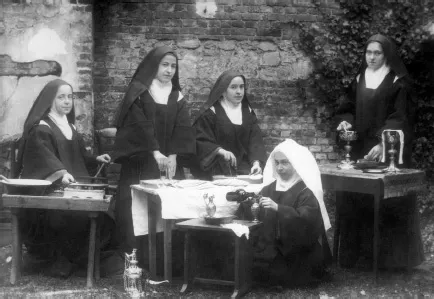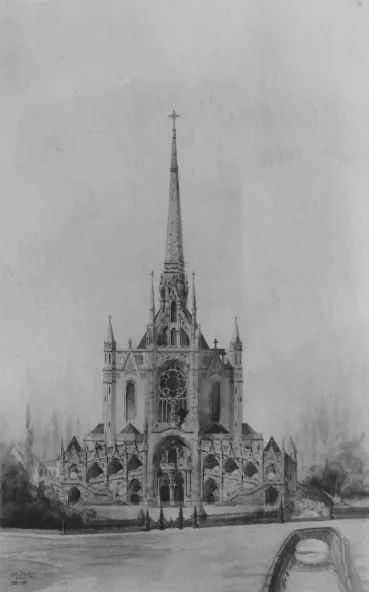![]()
Part I
Pilgrimage and modern journeys
![]()
1 Sisterly love in Lisieux
Building the Basilica of Sainte-Thérèse
Jessica Basciano
Sœur Thérèse of the Child Jesus and the Holy Face (1873–97) died in obscurity in the Carmelite convent in Lisieux, France, at the age of 24.1 However, owing to the immense appeal of her message of childlike trust in the love of God, which spread rapidly through the publication of her autobiography after her death, she soon became internationally famous and was canonized in 1925. Pope Pius X called her ‘the greatest saint of modern times’.2 The Basilica of Sainte-Thérèse (1929–54) was built in response to the resulting arrival of crowds of pilgrims in Lisieux, which overwhelmed the chapel of the Carmel (Figure 1.1). While architectural critics and historians have understood the Basilica of Sainte-Thérèse as belonging to the architectural tradition of the Sacré-Cœur on Montmartre (1874–1919) – pointing to its massive scale and Romanesque and Byzantine forms3 – in this chapter, I will consider the church from the perspective of the extraordinary growth of women’s religious orders in the nineteenth century. I will argue that the Carmelite nuns in Thérèse’s convent, including her biological sisters, played a vital role in building the church. The basilica was one aspect of how they shaped Thérèse’s legacy, along with editing and publishing her autobiography, and distributing her portrait. Drawing from the archives of the convent and the pilgrimage, I will show that the nuns bought property, raised funds and collaborated with architects on the design.
In 1925, the nuns planned to build a Gothic Revival church next to the convent, but two years later, they decided instead to execute the Romano-Byzantine design of Louis-Marie Cordonnier on a hill at the edge of the town. They balanced competing priorities: establishing the devotion to Thérèse, protecting their convent’s privacy and tranquillity and promoting a modern pilgrimage with mass ceremonies and the mobilization of Catholics by car, bus and train. While acknowledging the influence of the local bishop, the pilgrimage director and the pope, I will focus on the nuns’ authority in building the church and suggest that it demonstrates how religious vocations created an elite of women in the nineteenth century and the first half of the twentieth century.
One aspect of Thérèse’s appeal was her embodiment of a provincial bourgeois Catholic culture that many Catholics felt was under siege by the modern world.4 Her loving family life was an attractive model, and Thérèse’s devotees could often relate to her experience of death and loss from an early age. Thérèse Martin was born in Alençon, Normandy, the last of nine children, only five of whom survived to adulthood. Like Lisieux, Alençon became a site of pilgrimage, though to a lesser extent. In 1928, a neo-Baroque oratory designed by the Caen architect René Ménage (d. 1928) was completed next to her house. Through a grille in the oratory wall, visitors could see into the room in which she was born.5 Thérèse’s father was a well-off watchmaker and jeweller who sold his shop to help his wife with her even more successful lacemaking business. Thérèse’s mother died of breast cancer when she was only four. The family then moved to a house called Les Buissonnets in Lisieux. After her mother died, Thérèse identified an older sister, Pauline, as her new mother. So when Pauline left for the Carmelite convent in Lisieux when Thérèse was nine, she was devastated. At 15, she received special permission to enter the cloister herself, before the minimum age of 16. The exception was made following Thérèse’s petition to the pope himself, Leo XIII, during an audience on a pilgrimage to Rome. By 1894, four of the five Martin daughters had joined the community; the fifth became a visitationist (Figure 1.2). Sadly, this near-complete reunification of the sisters did not last long, as Thérèse first coughed up blood at Easter in 1896, and she died of tuberculosis in 1897 at the age of 24.
Figure 1.1 Louis-Marie Cordonnier, exterior view, Basilica of Sainte-Thérèse, Lisieux, 1929–54.
Figure 1.2 Sœur Geneviève de la Sainte-Face, photograph, Thérèse, her sisters and her cousin, November 1896
Despite living in a cloister, soon after her death, Thérèse became known internationally. In the last two-and-a-half years of her life, she had written her autobiography on the order of her sister Pauline, ‘Sœur Agnès’ in religion, who, for some of that time, was also the prioress. In 1898, a year after her death, the Lisieux Carmel printed 2,000 copies of the autobiography, which Sœur Agnès edited and gave the title Histoire d’une âme – Story of a Soul. They sent it to priests and the other French Carmels, instead of the usual obituary. Between 1898 and 1925, the year of Thérèse’s canonization, the autobiography was translated into 35 languages, and the convent distributed over 400,000 copies of the book and 2,000,000 abridged editions in French alone. During this period, the Carmel also sent out over 30,000,000 images of the saint.6 These were usually based on portraits painted by Céline, who was then known as ‘Sœur Geneviève’, or on photographs that she had taken – she had her own darkroom in the convent – and they became increasingly idealized and embellished over time.7 Meanwhile, Sœur Geneviève advised the Père Marie-Bernard, a Trappist sculptor, on the creation of a marble statue of Thérèse holding a crucifix and roses. Placed in front of the Carmel in 1923, it became the most famous statue of the saint, establishing her iconography: 300,000 copies were sold throughout the world.8
Beyond Thérèse’s identification with a bourgeois Catholic milieu, at the heart of her appeal was her message of God’s unconditional love. She rejected the theology of expiation and vicarious suffering that had permeated French Catholicism in the nineteenth century, and embraced instead a ‘little way’ (petite voie) of childlike trust in God and love for him, of pursuing holiness by performing everyday acts with love.9 She reassured the poor and disenfranchised of God’s accessibility, and many people could relate to the personal struggle with despair that she experienced during her illness. Her desire for daily communion and her teaching on the practice of the theological virtues of faith, hope and charity contributed to changes in the church in the twentieth century.10 Devotion to Thérèse was spurred by reports of miraculous healings as early as 1899 and by soldiers’ invocation of the saint for protection during the First World War.11 In addition to Thérèse’s embodiment of a besieged bourgeois Catholic culture and her reassuring message, her appeal may be understood in terms of what has been called the ‘feminization of religion’.12 In nineteenth- and early twentieth-century France, women attended Mass and took Easter communion more than men, and historians have suggested that this ‘sexual dimorphism’ affected the form of religion, particularly the increase in Marian devotion.13 Thérèse, like Mary, provided a model of female piety. Her life story, with its themes of innocence and withdrawal, resonated with Catholics alienated by modernity.14
With the support of the Catholic press and successive popes, Thérèse was beatified in 1923 and canonized in 1925. The cause advanced rapidly: Pope Benedict XV exempted it from the 50-year delay imposed by canon law.15 Thérèse belonged to an otherwise diverse group of French women who were canonized in the interwar period – a group that also included Joan of Arc, Marguerite-Marie Alacoque (canonized in 1920) and Bernadette Soubirous (sainted in 1933).16 Their gender points to the feminization of Catholicism; their nationality is indicative of a Franco-Vatican rapprochement.17
As devotion to Thérèse increased, crowds of pilgrims began to gather in Lisieux, demonstrating the continuation of the resurgence of pilgrimage that started in France in the 1840s and peaked in the 1870s.18 Pilgrims assembled first at the cemetery where Thérèse was buried and then at the Carmel chapel where her remains were transferred in 1923. The chapel, with its Baroque façade, was built in 1852 and expanded from 1919 to 1923 to accommodate pilgrims and a reliquary.19 This expansion was overseen by Pauline, who was then called ‘Mère Agnès’. She was re-elected prioress in 1909 and stayed in that role until she died in 1951.20 Fifty thousand people participated in the 1923 translation ceremony,21 but the chapel could only hold 600.22
In 1924, the nuns asked the vicar-general of Paris to recommend an architect for a new basilica dedicated to Thérèse.23 He endorsed Julien Barbier (1869–1940), an École des Beaux-Arts trained architect whose credentials included churches in the Paris suburbs, such as the Church of Saint-Maurice de Bécon in Courbevoie of 1911. Barbier went on to build over 50 churches during his career – buildings that are typically rustic and economical.24 While it was the local bishop, Msgr Thomas Lemonnier, who formally commissioned Barbier to design a basilica in the winter of 1925, the Carmelites requested numerous revisions and studies of side projects.25 Barbier’s earliest project dates to March 1925 (Figure 1.3). It was reproduced in the official journal of the pilgrimage the following year, when the bishop launched a subscription to pay for the basilica.26 Gothic, with a symmetrical triangular façade, it incorporates features that aid in the circulation of pilgrims – namely, portals opening onto superimposed churches and stairs and ramps leading to the upper church entrance.27 And it is reminiscent of the first two pilgrimage churches at Lourdes, completed in 1872 and 1889. The similarity makes sense, given the churches’ common function, and the fact that the pilgrimage journal had published a letter that compared the shrines, saying that ‘Lisieux has become a second Lourdes.’28 On the Carmelites’ orders, Barbier created a new project with a portico linking the basilica to the convent. However, the nuns interrupted Barbier’s work to ask him to design a monumental stations of the cross, then a hotel and, finally, a basilica with an altogether different program, incorporating the forms of a ship with three masts and a lighthouse – symbols that Thérèse had used in her autobiography.29 Thérèse was attracted to the image of a ship that cuts through rough waves and leaves no trace of its passing as a metaphor for life that captures its difficulty and transience. She used the lighthouse as a symbol of Jesus and of love, guiding her from life to the shores of eternity.30 In response to the nuns’ request, Barbier created a project with a pointed, prow-like west façade and three spires in the place of masts.31 Charles Jouvenot (b. 1861), an illustrator who worked for the nuns, interpreted the nautical program similarly. He had provided pictures for a children’s version of Thérèse’s autobiography and designed some of the decorative elements of the Carmel chapel.32 For the basilica, he proposed a convex west façade and three spires, as well as a campanile that resembles a lighthouse, which he identified as a beacon (Figure 1.4).33
Figure 1.3 Julien Barbier, façade elevation, project for the Basilica of Sainte-Thérèse,...



